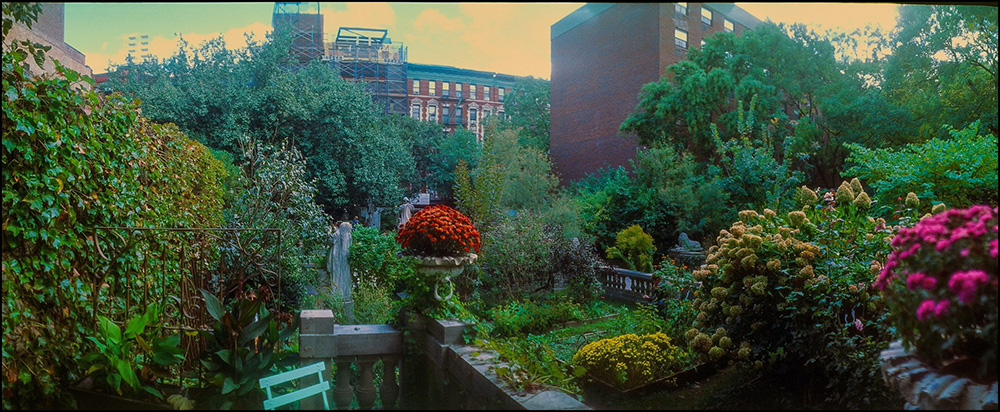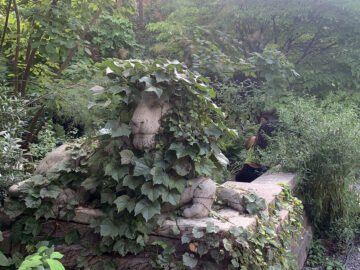by Katalin Balog
It may be that we have become so feckless as a people that we no longer care how things do work, but only what kind of quick, easy outer impression they give. If so, there is little hope for our cities or probably for much else in our society. But I do not think this is so. —Jane Jacobs, The Death and Life of Great American Cities, 1961
(Apology)
 There is a beautiful garden in a quiet tree-lined street in Manhattan’s Little Italy. There are rows of flower, lush, abundant and slightly wild, a stone balcony you can imagine Romeo climbing up to, stone balustrades, several lions, one with climbing vines adorning his face, a sphynx, various other statues, a copy of a Hermes medallion from the late antiquity, a fig tree and a hydrangea tree, giant shady pear trees, and many small hidden paths that lead to gazebos and intimate garden spaces. People in the garden sit and while the time or read by a little table. In a very small space, Elizabeth Street Garden has been able to replicate the richness of life, spaciousness of spirit, the magnanimity and dedication to beauty of the best Italian gardens. It is one of the truly great places in NYC. But after 12 years of struggle between the city and garden advocates, on June 18, 2024, the New York State Court of Appeals ruled six to one that the City of New York could destroy it to build a mix of affordable housing, luxury retail and office space in its place. In a Hail Mary pass, Martine Scorsese, Robert de Niro and Patti Smith wrote their own letters to the Mayor, imploring him to, in Smith’s words, “grant a stay of execution of the Elizabeth Street Garden”.
There is a beautiful garden in a quiet tree-lined street in Manhattan’s Little Italy. There are rows of flower, lush, abundant and slightly wild, a stone balcony you can imagine Romeo climbing up to, stone balustrades, several lions, one with climbing vines adorning his face, a sphynx, various other statues, a copy of a Hermes medallion from the late antiquity, a fig tree and a hydrangea tree, giant shady pear trees, and many small hidden paths that lead to gazebos and intimate garden spaces. People in the garden sit and while the time or read by a little table. In a very small space, Elizabeth Street Garden has been able to replicate the richness of life, spaciousness of spirit, the magnanimity and dedication to beauty of the best Italian gardens. It is one of the truly great places in NYC. But after 12 years of struggle between the city and garden advocates, on June 18, 2024, the New York State Court of Appeals ruled six to one that the City of New York could destroy it to build a mix of affordable housing, luxury retail and office space in its place. In a Hail Mary pass, Martine Scorsese, Robert de Niro and Patti Smith wrote their own letters to the Mayor, imploring him to, in Smith’s words, “grant a stay of execution of the Elizabeth Street Garden”.
The quirky, beautiful, art-filled space is the creation of long-time neighborhood denizen and outsider artist Allen Reiver who leased a blighted city-owned site in 1991 and filled it with greenery, architectural elements and neoclassical statuary from his own collection as an antique’s dealer. His son Joseph, who worked with his father on creating the Garden, and who is now its executive director, has kept it – with the help of an army of volunteers – open for all and busy with concerts, poetry readings, movie nights, art exhibits, performances, yoga and gardening. With 200,000 annual visitors and hordes of devoted neighborhood regulars, the Elizabeth Street Garden should be designated a New York Landmark. But instead, it is in a life and death struggle to survive.
One might wonder if the imperative to build more affordable housing just might outweigh the neighborhood’s sentimental attachment to this magical space. The call for bold action on housing in the city and in the country is amply justified. And yet… it is not true that we should build absolutely everywhere we possibly can. In a neighborhood and city that is steadily losing its edge and character, there is a case to be made that such decisions need to be tempered by sensitivity to the organic quality of life in a neighborhood, to what it is like to live or work here. The sum total of all this is what makes New York the great city it is. The city has portrayed this choice all along as a choice between two desirables: affordable housing and green space. Its answer: since the housing crisis is more dire than the crisis involving green space, the former has to be prioritized. The problem with this framing is that we are not talking about a vacant lot whose future is yet to be decided. Even granting that we need to prioritize housing in this area – a conclusion made questionable by the fact that Soho/Little Italy where Elizabeth Street Garden is located has an open space ratio of 0.07 acre per 1,000 residents (3 square feet per resident), compared with the City’s open space planning goal of at least 2.5 acres per 1,000 residents (109 square feet per resident) – still, the conclusion, that Elizabeth Street Garden should be destroyed, does not follow. We don’t just look at buildings, concluding they should be destroyed, in neighborhoods starved for greenery. Similarly, we don’t weight the pros and cons of destroying Central Park, or, for that matter, Collect Pond Park, a few blocks south of Elizabeth Street Garden to make room for affordable housing. There are alternative sites, vacant lots to build on.
In other words, the situation is quite different from how it is officially portrayed. It is not just that supporters of green space in general, abstract terms, will be disappointed by not getting some green space. It is that an existing, beloved place will be cut out of the body of this neighborhood, irreparably. If destroyed, the neighborhood will mourn the destruction of the Garden for decades to come. Its destruction is one of the costs of the project. Gardens are not just an “amenity”, as the city likes to call them. A neighborhood whose beating heart has been ripped out of it will be a cheerless place.
As Jane Jacobs observed in “The Death and Life of Great American Cities”: “The trust of a city street is formed over time from many, many little public sidewalk contacts. Most of it is ostensibly trivial but the sum is not trivial at all.” When Jane Jacobs opposed and successfully fought Robert Moses’s plan to run a “Lower Manhattan Expressway” through Greenwich Village, Soho and Little Italy 50 years ago, she didn’t merely avert catastrophe for Downtown Manhattan and win a local – although hugely important and consequential – battle, but won against, more generally, impoverished ideas and pseudo-scientific formulas in city planning. Through her advocacy and her wildly influential book The Death and Life of great American cities, she garnered widespread support for the idea that the life of a city consists of more than can be summed up in the abstract categories of transportation efficiency, affordable housing, economic development, environmental planning, recreational space, etc. It includes factors such as a sense of community and belonging, the opportunity to reflect and to participate. Above all, she understood that city planning is at its best when it doesn’t set various priorities against each other, and when it disrupts the organic life of neighborhoods as little as possible by heavy handed interventions.
In a small scale, the city’s decision reflects the same carelessness and indifference to the intangibles of life that went into the decision to withdraw land from national monuments in Utah and authorize oil drilling in the Arctic National Wildlife Refuge. What makes these actions so infuriating and agonizing is that what is done to destroy nature cannot be undone. Similarly, a garden, once it is gone, is gone forever. As Joseph Reiver pointed out, “The city will never build something like the Elizabeth Street Garden.”
(Peroration)
The world stamps its meaning, mood and emotion on us. We are different beings in a garden and in a plastic cubicle and whereas the latter has utility, the former has beauty. Both are necessary in a city. No city could be great where there are no places to just be.
The garden is an expression of longing for harmony with nature – a longing for innocence, for a Paradise lost. Heaven on earth is a garden. Hell, on the other hand, is a barren, rocky place where nothing grows, nothing lives. There is something hellish, as well, in cities without greenery.
The grounds and statuary of Elizabeth Street Garden – like the best gardens everywhere – amplifies the goodness of nature. It is exuberant and a little over the top, and inspires an experience of the sublime, moments of intense inwardness. It has become a community hub precisely because of the uplift it provides. In channeling nature’s energy in a busy neighborhood, it urges us to match it with the quality of our own being. Our usual sloppiness seems out of place in such an environment. It encourages us to leave agendas behind and enjoy some moments of freedom and connection. It embodies a heightened sense of what our lives can be – the opposite of meaningless drudgery, of filling quotas of monetizable things. It is a reminder that life depends on something more fundamental than technology.
To have access to a garden is a privilege. But at the same time, it fulfills a simple human need that doesn’t have to do with greed or domination: to have a direct connection to Earth, for the soul and the world to mingle unimpeded. It is our birthright as humans. This is why people love the moon. Though the moon is a great and mysterious celestial object, we all have a direct and unimpeded path to it, uncluttered by things or people… a direct pipeline that feels is ours alone. The Garden might or might not survive. But the moon will always shine and remind us that we need more than stone, brick, steel and glass.
If you are so moved, please send Mayor Eric Adams a pre-written letter to urge him to step in and save the Garden before it is too late.

